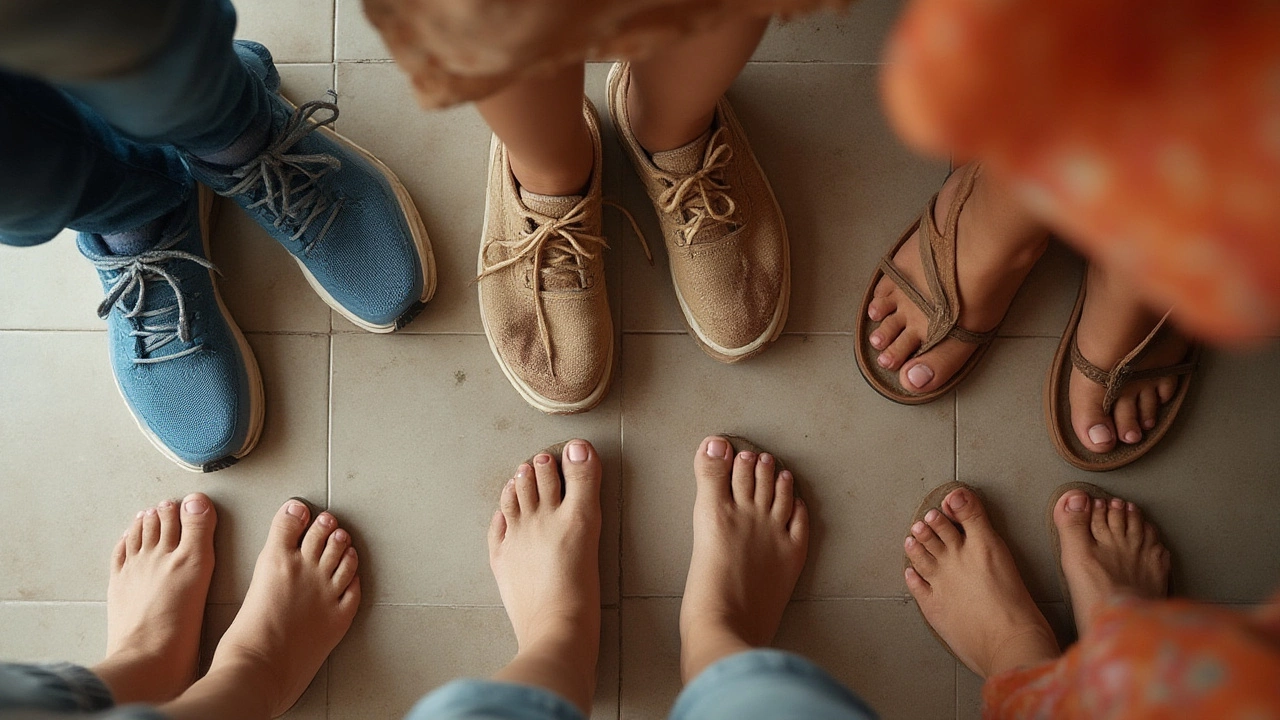Look down at your feet. Are you lacing up your favorite running shoes, even though you’re headed out just for a walk? There’s a good chance you are, because let’s be real—running shoes aren’t just popular among runners. Tons of people grab them for walking, errands, and travel. But is that actually the best choice? Or are you missing out on shoes made specifically for walking? The answer isn’t as obvious as you might think.
How Running Shoes and Walking Shoes Really Differ
Most folks don’t pay much attention to the difference between running and walking shoes. To the naked eye, they kind of look the same, but peek under the hood and you’ll spot important details. Running shoes usually have more cushioning, with advanced foam or gel that absorbs the shock when your feet pound the pavement. They’re often designed with a thicker heel and a noticeable “heel-to-toe drop”—that’s sneaker talk for how much higher the heel is compared to the toe. This makes it easier to roll forward when you’re running, landing on your heel and pushing off the toe.
Walking shoes, on the other hand, are designed with flatter soles and less dramatic heel drops. Why? Because your foot movement is different when you walk compared to when you run. Walkers roll through their step in a smoother motion with less impact, so extra cushioning isn’t usually necessary. Stability is the main thing here. Walking shoes often have firmer midsoles, keeping your foot steady and preventing it from rolling too much, which can lead to injury over time.
Here’s something interesting: a 2021 study from the American Academy of Podiatric Sports Medicine found that people who wore running shoes for regular walking noticed more foot fatigue after 60 minutes, compared to those in proper walking shoes. Not to say running shoes are bad for walking, but they’re just not always perfect for it.
If you’ve ever wondered why running shoes feel clunkier when you’re power-walking around the park, now you know. That extra padding is awesome for sprints, but it’s not always the comfiest fit for those long strolls.
Should You Actually Wear Running Shoes for Walking?
This is where things get a little nuanced. Can you wear running shoes for walking? Of course. Most people do it, and brands even suggest their shoes are “all-day comfortable.” If you’re just heading out for a short walk, picking up groceries, or spending time on your feet while traveling, running shoes can give you a soft, cloud-like cushion. For folks who are on the heavier side or have certain joint concerns, the extra cushion can be a real bonus and provide much-needed comfort.
But, if you’re doing long-distance walking or have any foot problems, things get more complicated. Consistently wearing shoes that aren’t designed for walking can make your feet work in weird ways, sometimes putting pressure where it shouldn’t be. Instead of letting the foot flex naturally, overly cushioned running shoes can force the muscles and tendons into unnatural positions. That’s how some walkers pick up aches in the arch, shins, or even lower back that seem to appear out of nowhere.
If you walk several miles each day for exercise, you’ll want a shoe that matches your stride. Remember the stats: About 60% of people develop some kind of foot pain if they walk more than three miles a day in shoes built only for running. That’s a decent chunk.
Here's a quick comparison table to break it down:
| Shoe Type | Heel Height | Arch Support | Sole Flexibility | Cushioning |
|---|---|---|---|---|
| Running Shoes | Higher | Varied | More flexible in forefoot | Maximum |
| Walking Shoes | Lower | Stronger | Even flexibility | Moderate |
So yes, running shoes can double up if you’re walking now and then, but for daily long walks or power walks, grab shoes meant just for walking. Your feet will thank you.

What Are the Advantages of Wearing Running Shoes for Walking?
Still, running shoes aren’t just for runners. They really shine in a few specific ways if you’re using them for walking. First off, their running shoes for walking style is popular with designers, so you can find all sorts of colors, patterns, and techy features. In other words, they look good and feel modern. If you like to walk and then break into the occasional jog, hybrid models (sometimes called “run-walk shoes”) can do double duty without skipping a beat.
Another plus: Running shoes tend to be lighter than walking shoes. Their lighter materials translate into less drag. That does make a difference if you have quick steps or are walking for hours, especially if you’re packing shoes for a trip. Plus, their mesh uppers are often more breathable, keeping feet cool and dry—no more sweaty socks at the end of the day.
Running shoes are great shock absorbers. If you’re pounding pavement or walking on hard urban sidewalks—which a lot of us do—you’ll feel every crack, ridge, and change in concrete. The built-in cushion takes the sting out and helps prevent sore knees or tired calves by bedtime. That feature can also be a win if you’re recovering from a mild foot injury or coming back to fitness after a break.
One underappreciated perk: the variety of widths and arch supports running shoe brands offer. If you’ve ever had trouble finding walking shoes in your size, especially if you have wide or narrow feet, you’ll notice that running brands usually carry tons of sizes, widths, and support options. So for people with high arches, flat feet, or bunions, a good pair of running shoes might fit better than any old “walking” style.
In short, if you’re looking for that sweet spot between style, comfort, breathability, and shock protection, running shoes do the trick—just be aware of your own walking habits and comfort level.
Potential Drawbacks You Should Know Before Picking Running Shoes for Walking
It’s not all sunshine and roses, though. Relying only on running shoes can backfire if you’re not careful. One of the biggest trip-ups is that all that cushioning and structure means these shoes tend to wear out faster when used for walking. You might be thinking, “But I’m not running marathons!”—and that’s true, but your shoes can break down from repeated pressure in different places. Worn-down soles or support in the wrong spots can sneak up on you after six months of daily walks. That equals less stability and risk for your ankles or knees.
Then, there’s the matter of pronation and motion control. “Pronation” just means the way your foot rolls inward when you walk. The best walking shoes steer your foot in a neutral direction, reducing overpronation or supination (rolling out). Many running shoes are built to control this while running—a much bigger, more forceful motion than walking. So if you’re just cruising around the neighborhood, that kind of built-in correction can actually throw your natural stride off, leaving you sore or tired.
And don’t forget: many running shoes have a bigger heel. For some, this can change walking mechanics, pushing weight forward and creating odd pressures in your hips or back. This especially matters if you already have low back issues or any kind of nerve pain in the legs.
Moisture can also become a drawback. Some running shoes are so focused on being lightweight and airy that they’re not built for rainy days or trails. You’ll get great airflow, but step in a puddle, and your socks might as well be in a swimming pool.
Last but not least—cost. High-tech running shoes can get pricey, sometimes double or triple what you’d pay for dedicated walking models. If you’re burning through pairs every few months, it starts to add up.

Tips to Get the Most Out of Running Shoes for Walking
If you’re set on using running shoes for walking, you can make it work with a few smart tweaks. First up, find your personal walking stride and get shoes that match your body, not just the latest drop. Try them on at the end of the day (since feet swell after hours of standing), and wear the socks you usually walk in to make sure you’re getting the right fit.
Look for models marked as “neutral” if your feet don’t have special needs. For flat feet or high arches, don’t guess—many running stores offer free gait analysis to figure out how your feet move. This helps you pick shoes that support natural movement, not fight against it.
Check that the heel-to-toe drop isn’t too dramatic. Shoes with a lower drop will feel better for most walks so you can move smoothly and avoid knee or hip twinges on longer routes. Flex the shoe in your hand—a good walk-friendly shoe should bend in the forefoot but not collapse like a slipper.
Don’t forget to rotate your shoes. Alternate if you can, especially if you’re doing both running and walking in the same week. You’ll extend the lifespan and keep cushioning fresh.
- Replace shoes every 500-800 kilometers (roughly 350-500 miles) or when the treads start to look flat.
- If you walk in rainy or muddy spots, grab a second pair for wet weather, or buy waterproof sprays.
- Swap out the insoles for something with more arch support if you ever feel tenderness in the arches or heels.
- Let shoes dry out fully if they get damp—stuff them with newspaper or use a shoe dryer overnight.
- Keep an eye on your feet. If you start getting blisters, aches, or sharp pains, don’t tough it out. Try another style or see a podiatrist.
When in doubt, always put comfort first. If your running shoes are working for your walks—no aches, no pains, no tightness—you’re probably fine. But if you notice irritation or pain, it’s time to switch up your footwear.

